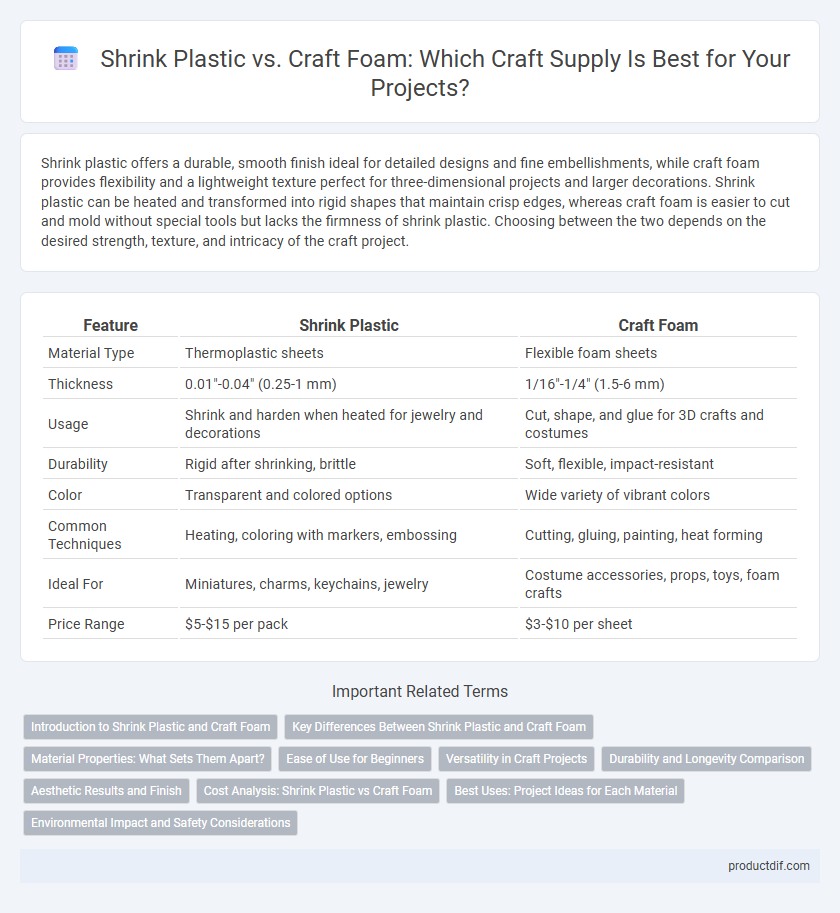Shrink plastic offers a durable, smooth finish ideal for detailed designs and fine embellishments, while craft foam provides flexibility and a lightweight texture perfect for three-dimensional projects and larger decorations. Shrink plastic can be heated and transformed into rigid shapes that maintain crisp edges, whereas craft foam is easier to cut and mold without special tools but lacks the firmness of shrink plastic. Choosing between the two depends on the desired strength, texture, and intricacy of the craft project.
Table of Comparison
| Feature | Shrink Plastic | Craft Foam |
|---|---|---|
| Material Type | Thermoplastic sheets | Flexible foam sheets |
| Thickness | 0.01"-0.04" (0.25-1 mm) | 1/16"-1/4" (1.5-6 mm) |
| Usage | Shrink and harden when heated for jewelry and decorations | Cut, shape, and glue for 3D crafts and costumes |
| Durability | Rigid after shrinking, brittle | Soft, flexible, impact-resistant |
| Color | Transparent and colored options | Wide variety of vibrant colors |
| Common Techniques | Heating, coloring with markers, embossing | Cutting, gluing, painting, heat forming |
| Ideal For | Miniatures, charms, keychains, jewelry | Costume accessories, props, toys, foam crafts |
| Price Range | $5-$15 per pack | $3-$10 per sheet |
Introduction to Shrink Plastic and Craft Foam
Shrink plastic is a versatile crafting material that shrinks and thickens when heated, allowing for the creation of durable, lightweight charms, jewelry, and embellishments. Craft foam, made from flexible, spongy sheets, offers easy cutting and shaping for projects like stamps, decorations, and costumes. Both materials provide unique textures and applications, making them essential for diverse craft projects.
Key Differences Between Shrink Plastic and Craft Foam
Shrink plastic is a lightweight, rigid material that shrinks and hardens when heated, allowing for detailed, durable designs suitable for jewelry and charms. Craft foam is a flexible, soft material available in sheets or shapes, ideal for creating textured, dimensional crafts and child-friendly projects due to its ease of cutting and shaping. The key differences lie in their physical properties, heat responsiveness, and final texture, making shrink plastic better for precision and durability, while craft foam excels in versatility and safety.
Material Properties: What Sets Them Apart?
Shrink plastic features a rigid, translucent polymer that contracts and thickens when heated, offering precise detail retention and a durable finish ideal for intricate designs. Craft foam consists of a lightweight, flexible polymer material known for its soft texture, ease of cutting, and cushioning properties, making it suitable for 3D effects and tactile projects. The key distinction lies in shrink plastic's heat-responsive rigidity and shrinkage compared to craft foam's pliability and cushioning, influencing their respective applications in crafting.
Ease of Use for Beginners
Shrink plastic offers straightforward cutting and coloring options, making it accessible for beginners who want precise and detailed designs with minimal effort. Craft foam provides a softer, more forgiving medium that is easy to cut and shape, ideal for quick crafts and tactile projects without needing advanced skills. Both materials support beginner-friendly crafting, but shrink plastic demands careful heating, while craft foam allows immediate handling and reuse.
Versatility in Craft Projects
Shrink plastic offers high versatility in craft projects, allowing creators to design detailed charms, keychains, and jewelry with vibrant colors that shrink and harden when heated. Craft foam provides flexibility and ease of use, making it ideal for three-dimensional crafts, costumes, and foam stamps that require lightweight, durable materials. Both materials serve unique roles in crafting, but shrink plastic excels in fine detail work, while craft foam is preferable for larger, tactile projects.
Durability and Longevity Comparison
Shrink plastic offers higher durability and longevity compared to craft foam due to its rigid, heat-hardened structure that resists wear and tear over time. Craft foam, while flexible and lightweight, is more prone to bending, denting, and degradation from frequent handling or exposure to moisture. For projects requiring long-lasting sturdiness, shrink plastic is the preferred choice, offering a robust, resilient finish.
Aesthetic Results and Finish
Shrink plastic offers a glossy, durable finish ideal for detailed, vibrant designs, providing a polished and professional look that resists wear over time. Craft foam delivers a soft, matte appearance with a dimensional, tactile quality suited for layering and textured projects but may lack the crispness and longevity of shrink plastic. For intricate, sleek, and long-lasting aesthetic results, shrink plastic outperforms craft foam in vibrancy and finish quality.
Cost Analysis: Shrink Plastic vs Craft Foam
Shrink plastic offers a higher upfront cost due to specialized tools and materials, while craft foam is generally more budget-friendly with inexpensive sheets and minimal tools required. Craft foam's versatility and reusability provide cost savings for large or repetitive projects, whereas shrink plastic delivers detailed, durable finished pieces that may justify its higher price for premium crafts. Evaluating project scale and quality requirements helps determine if the cost efficiency of craft foam or the superior finish of shrink plastic aligns better with budget constraints.
Best Uses: Project Ideas for Each Material
Shrink plastic works well for detailed jewelry pieces, keychains, and custom charms, offering a durable and glossy finish after baking. Craft foam is ideal for larger, lightweight projects like costumes, masks, and 3D decorations due to its flexibility and ease of cutting. Both materials support vibrant colors and customization, making them perfect for diverse DIY craft projects.
Environmental Impact and Safety Considerations
Shrink plastic generates less non-biodegradable waste compared to craft foam, which often contains PVC and other harmful chemicals contributing to long-term environmental pollution. Craft foam poses greater fire hazards due to its flammability and releases toxic fumes when burned, whereas shrink plastic, though requiring careful ventilation during heating, produces fewer toxic byproducts. Recycling options for shrink plastic are limited but generally less hazardous than the disposal challenges associated with non-recyclable craft foam materials.
Shrink plastic vs Craft foam Infographic

 productdif.com
productdif.com